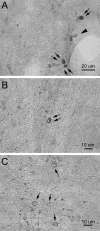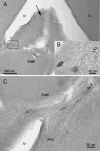Transplantation of hypocretin neurons into the pontine reticular formation: preliminary results
- PMID: 15683135
- PMCID: PMC1201562
- DOI: 10.1093/sleep/27.8.1465
Transplantation of hypocretin neurons into the pontine reticular formation: preliminary results
Abstract
Study objectives: The sleep disorder narcolepsy is now considered a neurodegenerative disease because there is a massive loss of neurons containing the neuropeptide, hypocretin, and because narcoleptic patients have very low cerebrospinal fluid levels of hypocretin. Transplants of various cell types have been used to induce recovery in a variety of neurodegenerative animal models. In models such as Parkinson disease, cell survival has been shown to be small but satisfactory. Currently, there are no data indicating whether hypocretin neurons can survive when grafted into host tissue. Here we examined the survival of hypocretin-containing neurons grafted into the pontine reticular formation, a region traditionally regarded to be key for rapid eye movement sleep generation.
Design: In 2 experiments, a suspension of cells from the posterior hypothalamus of 8- to 10-day old rat pups was injected into the pons (midline, at the level of the locus coeruleus) of adult rats. Control rats received cells from the cerebellum, tissue that is devoid of hypocretin neurons. In the first experiment (n = 33), the adult rats were sacrificed 1, 3, 6, 12, 24, or 36 days after transplant, and cryostat-cut coronal sections of the brainstem were examined for presence of hypocretin-immunoreactive neurons. In the second experiment (n = 9), the transplant medium was modified to include agents that stimulate cell growth, and recipient rats were sacrificed 9, 12, and 36 days after receiving the graft.
Settings: Basic neuroscience research laboratory.
Measurements and results: In the first experiment, clearly defined hypocretin-immunoreactive containing somata and varicosities were visible in pons of rats sacrificed 1 day after grafting of posterior hypothalamic cells but not in rats receiving cerebellum tissue. The hypocretin-immunoreactive somata were not visible in rats sacrificed at 12, 24, or 36 days, indicating that the neurons had died. However, in the second experiment, where enriched transplant medium was used, clearly defined hypocretin-immunoreactive somata with processes and varicosities were present in the graft zone 36 days after implant. These somata were similar in size and appearance to adult rat hypocretin-immunoreactive neurons.
Conclusions: These results indicate that hypocretin neurons obtained from rat pups can be grafted into a host brain, and efforts should be made to increase survival of these neurons.
Conflict of interest statement
This is not an industry supported study. Drs. Arias-Carrion, Murillo-Rodriguez, Xu, Blanco-Centurion, Drucker-Colin, and Shiromani have indicated no financial conflicts of interest.
Figures



Similar articles
-
Survival rates through time of hypocretin grafted neurons within their projection site.Neurosci Lett. 2006 Aug 14;404(1-2):93-7. doi: 10.1016/j.neulet.2006.05.017. Epub 2006 Jun 9. Neurosci Lett. 2006. PMID: 16762505
-
Dorsomedial pontine neurons with descending projections to the medullary reticular formation express orexin-1 and adrenergic alpha2A receptor mRNA.Neurosci Lett. 2009 Aug 14;459(3):115-8. doi: 10.1016/j.neulet.2009.05.011. Epub 2009 May 7. Neurosci Lett. 2009. PMID: 19427365 Free PMC article.
-
REM sleep enhancement and behavioral cataplexy following orexin (hypocretin)-II receptor antisense perfusion in the pontine reticular formation.Sleep Res Online. 1999;2(4):112-20. Sleep Res Online. 1999. PMID: 11382892
-
Cell transplantation: a future therapy for narcolepsy?CNS Neurol Disord Drug Targets. 2009 Aug;8(4):309-14. doi: 10.2174/187152709788921681. CNS Neurol Disord Drug Targets. 2009. PMID: 19689312 Review.
-
Pontine reticular formation (PnO) administration of hypocretin-1 increases PnO GABA levels and wakefulness.Sleep. 2008 Apr;31(4):453-64. doi: 10.1093/sleep/31.4.453. Sleep. 2008. PMID: 18457232 Free PMC article. Review.
Cited by
-
Narcolepsy: current treatment options and future approaches.Neuropsychiatr Dis Treat. 2008 Jun;4(3):557-66. Neuropsychiatr Dis Treat. 2008. PMID: 18830438 Free PMC article.
-
Recent advances in the treatment of narcolepsy.Curr Treat Options Neurol. 2011 Oct;13(5):437-57. doi: 10.1007/s11940-011-0137-6. Curr Treat Options Neurol. 2011. PMID: 21748548
-
The development of hypocretin (orexin) deficiency in hypocretin/ataxin-3 transgenic rats.Neuroscience. 2007 Aug 10;148(1):34-43. doi: 10.1016/j.neuroscience.2007.05.029. Epub 2007 Jul 6. Neuroscience. 2007. PMID: 17618058 Free PMC article.
-
Effects of hypocretin/orexin cell transplantation on narcoleptic-like sleep behavior in rats.PLoS One. 2014 Apr 15;9(4):e95342. doi: 10.1371/journal.pone.0095342. eCollection 2014. PLoS One. 2014. PMID: 24736646 Free PMC article.
-
Hypocretin ligand deficiency in narcolepsy: recent basic and clinical insights.Curr Neurol Neurosci Rep. 2010 May;10(3):180-9. doi: 10.1007/s11910-010-0100-z. Curr Neurol Neurosci Rep. 2010. PMID: 20425033 Review.
References
-
- Guilleminault C. Anagnos A. Narcolepsy. In: Kryger MH, Roth T, Dement WC, eds. Principles and Practice of Sleep Medicine. Philadelphia: WB Saunders; 2000:676–86.
-
- Peyron C, Farco J, Rogers W, et al. A mutation in a case of early onset narcolepsy and a generalized absence of hypocretin peptides in human narcoleptic brains. Nat Med. 2000;6:991–7. - PubMed
-
- Sakurai T, Amemiya A, Ishii M, et al. Orexins and orexin receptors: a family of hypothalamic neuropeptides and G protein-coupled receptors that regulate feeding behavior. Cell. 1998;92:573–85. - PubMed
Publication types
MeSH terms
Substances
Grants and funding
LinkOut - more resources
Full Text Sources
Other Literature Sources

